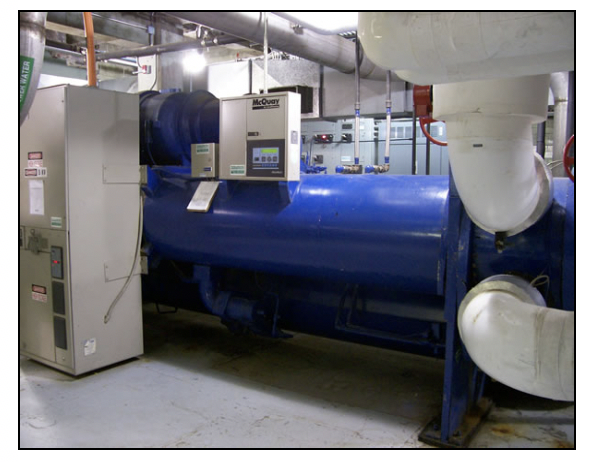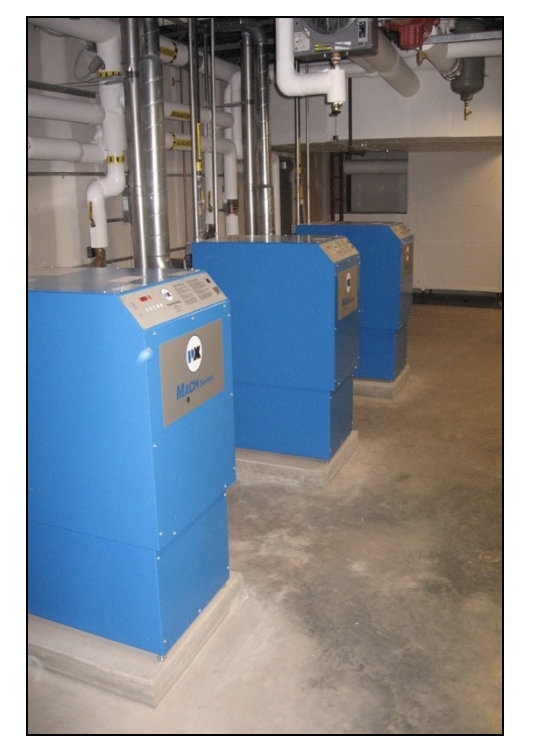Properly-Sized, High-Performance HVAC Equipment and Controls
Existing CommercialWhat are Properly-Sized, High-Performance HVAC Equipment and Controls?
Heating, ventilating, and air-conditioning (HVAC) systems consume 40% of the energy used in commercial buildings, providing opportunities for significant energy savings (10-40%), especially in existing buildings by replacing aging systems with properly-sized, high-performance HVAC systems and controls.[1] Each successive generation of HVAC equipment tends to be more efficient than the previous generation as a result of improved or new technology and design. In addition, as HVAC systems age and parts of the system experience decline in performance or failure due to wear and tear, the system becomes less efficient. Also, design engineers often oversize HVAC systems to comply with code or to meet the most extreme loads such as the coldest and hottest days of the year, and design systems with a built-in capacity for overloads which occur only 1% to 2.5% of the time.[2] Oversized equipment can result in higher installation and capital costs, reduced operating efficiency, and potential negative impacts on comfort. For example, short-cycling or excessive cycling of air conditioning equipment can lead to poor humidity control and moisture or mold issues and contributes to the wear and tear and longevity of equipment. Oversized systems use more fan power for blowers and can increase peak demand during the cooling season, leading to higher energy costs.[3] Oversizing can occur for a variety of reasons. Contractors may use standard rules of thumb based on experience rather than industry accepted practices and customers often request oversized units without understanding the calculations that go into sizing equipment or to accommodate planned expansions.[4]
Furthermore, many existing buildings are never commissioned to ensure that HVAC systems and HVAC controls, which regulate HVAC systems to maintain occupant comfort and save energy, are working correctly (see Re-Commissioning). Controls give operations and maintenance personnel the ability to monitor and adjust the HVAC system based upon real-time changes in the outdoor environment and indoor occupancy levels (see Smart Sensors and Controls). Controls include but are not limited to programmable thermostats to reduce heating and cooling loads (temperature), variable frequency drives (ventilation), occupancy sensors (lighting), and system integrated windows, all of which can have a significant impact upon the indoor environmental quality of a given space. Ongoing training for building operators and commissioning can ensure that HVAC systems and controls work effectively.
Properly-sized, high-performance HVAC equipment, and controls consider the interaction among building systems, and the potential synergies and contradictions among these systems, taking into account the energy savings achieved through building envelope strategies, smart controls, and occupant behaviors when selecting equipment and designing air distribution systems (see Integrated Design Process, Roof Replacement and Upgrades, Windows and Skylights, and Exterior Wall System Upgrades).

Figure 1 – A High-Efficiency Electric Chiller (Source: Association for Advancement of Sustainability in Higher Education)
How to Implement Properly-Sized, High-Performance HVAC Equipment
First, commission the HVAC system or conduct commissioning on the whole building that includes a comprehensive energy audit to determine the costs and benefits of energy efficiency improvements, operation and maintenance changes, and HVAC equipment upgrades. The evaluation process should include an examination of all the components of the HVAC systems for wear and tear, from the most expensive components to the piping and insulation.[5] Use the results of the energy audit and final commissioning report to incorporate energy-efficient strategies that reduce heating and cooling loads. Select appropriately sized, high-performance HVAC equipment and controls that reflect the impact of different energy-efficient design measures and building operations on peak heating and cooling loads and overall system loads as well as how often the system runs on part load (see Chilled Beams, Demand Control Ventilation, Natural Ventilation, Thermal Energy Storage, and Variable Frequency Drives). Consider part-load performance when selecting equipment as most heating, and cooling equipment fails to operate at peak efficiency unless fully loaded (see Part-Load Efficiency).[6] One approach to downsizing HVAC equipment uses a small, efficient system to manage normal loads, and designates a backup system or relies on energy storage for extreme conditions that demand additional load capacity and occur less frequently (see Energy Storage and Back-up Power Generation, Thermal Energy Storage).[7] In general, properly sizing HVAC equipment avoids providing excess capacity and allocates extra physical space for additional equipment and designs modular distribution systems that can accept additional equipment for future expansion.[8]
The Air Conditioning Contractors of America (ACCA), Manual N, “Commercial Load Calculation,” and provides industry-accepted standards for properly sizing HVAC systems, and the ACCA Manual Q, “Commercial Duct Design,” provides guidance and performance criteria for duct system design.

Figure 2 – Heating system composed of several gas-fired boilers controlled by variable frequency drives that optimize boiler operation (Source: Rutgers University)
Example
GSA’s Emerging Building Technologies – HVAC Published Findings
The General Service Administration’s Emerging Building Technologies program publishes case study findings, such as innovative and cost-effective HVAC technologies to inform decision making on federal buildings.
Benefits
Properly-sized, high-performance HVAC equipment and controls reduce energy consumption, water use and emissions, provide cost savings, manage occupant comfort and maintain indoor air quality.
Costs
Incorporating a whole-building energy-saving approach including envelope strategies, high-performance lighting, and energy-efficient windows can reduce peak heating and cooling loads and result in smaller HVAC systems that cost less upfront than larger capacity models and save 30% on average on annual utility costs (see High-Efficiency Lighting and Networked Lighting Controls, and Windows and Skylights).[9] Additional upfront costs for commissioning and energy audits often pay for themselves through realized energy and cost savings.
For information on available HVAC equipment incentives, visit The New Jersey Clean Energy’s Smart Start Building Program. State incentives tend to be in the form of low-interest loans, grants, and tax incentives for the greening of buildings.[10]
Resiliency
Properly-sized, high-performance HVAC equipment and controls increase resiliency by decreasing energy and water consumption and peak loads which decreases reliance and stress on the electricity grid natural gas, water, and wastewater infrastructure.
[1] Whole Building Design Guide. 2016. HVAC Interaction of the Building Envelope. http://www.wbdg.org/resources/env_hvac_integration.php (accessed May 23, 2018).
[2] Whole Building Design Guide. 2016. High-Performance HVAC. National Institute of Building Science. https://www.wbdg.org/resources/high-performance-hvac (accessed Nov 28, 2018).
[3] NREL. Right-Size Heating and Cooling Equipment. https://www.nrel.gov/docs/fy02osti/31318.pdf (accessed May 23, 2018).
[4] NREL. Right-Size Heating and Cooling Equipment. https://www.nrel.gov/docs/fy02osti/31318.pdf (accessed May 23, 2018).
[5] ENERGY STAR Building Manual. https://www.energystar.gov/sites/default/files/buildings/tools/EPA_BUM_CH9_HVAC.pdf “Heating and Cooling System Upgrades” (accessed May 28, 2018).
[6] Whole Building Design Guide. 2016. High-Performance HVAC. National Institute of Building Science. https://www.wbdg.org/resources/high-performance-hvac (accessed Nov 28, 2018).
[7] Roth, Amir. 2017. “Building Energy Modeling 101: HVAC Design and Operation Use Case.” US DOE Building Technologies Program. https://www.energy.gov/eere/buildings/articles/building-energy-modeling-101-hvac-design-and-operation-use-case (accessed Nov 26, 2018).
[8] Whole Building Design Guide. 2016. High-Performance HVAC. National Institute of Building Science. https://www.wbdg.org/resources/high-performance-hvac (accessed Nov 28, 2018).
[9] Whole Building Design Guide. 2016. High-Performance HVAC. National Institute of Building Science. https://www.wbdg.org/resources/high-performance-hvac (accessed Nov 28, 2018).
[10] US DOE. “Tax Credits, Rebates, & Savings” https://www.energy.gov/savings/search?keyword=HVAC&f%5B0%5D=im_field_rebate_state%3A860091 (accessed May 28, 2018).
Related Strategies
- Air Infiltration
- Chilled Beams
- Demand Control Ventilation
- Energy Storage and Back-up Power Generation
- Exterior Walls System Upgrades
- High-Efficiency Lighting and Networked Lighting Controls
- Integrated Design Process
- Natural Ventilation
- Part-Load Efficiency
- Roof Replacement and Upgrades
- Smart Sensors and Controls
- Thermal Energy Storage
- Windows and Skylights
- Variable Frequency Drives
Resources
- Air Conditioning Contractors of America (ACCA)
- American Society of Heating, Refrigerating and Air-Conditioning Engineers (ASHRAE)
- Database of State Incentives for Renewables and Efficiency
- NJ’s Clean Energy Program
- Sustainable Facilities Tool
ENERGY STAR
- Building Program – Heating and Cooling System Upgrades
- Maintenance Checklist
- Verified HVAC Installations (ESVI)
US DOE
- Building Technologies Program Strategy Guideline: HVAC Equipment Sizing
- Computer Program Listing for a range of HVAC measurements and calculations
Whole Building Design Guide
